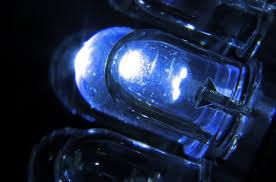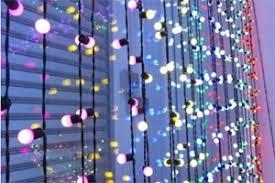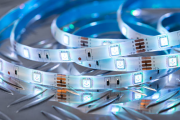2 LED Optical Characteristics
2.4 Luminous efficiency and visual acuity
LED lumen efficiencies
The following lists several common LED lumen efficiencies (visible light luminous efficiency):
| LED light color |
λp (nm) |
Material |
Visible light luminous efficiency (lm/w) |
External quantum efficiency |
|
|
highest value |
average value |
||||
| Red |
700 660 650 |
GaP:Zn-O GaAlAs GaAsP |
2.4 0.27 0.38 |
12 0.5 0.5 |
1~3 0.3 0.2 |
| Yellow |
590 |
GaP:N-N |
0.45 |
0.1 |
|
| Green |
555 |
GaP:N |
4.2 |
0.7 |
0.015~0.15 |
| Blue |
465 |
GaN |
10 |
||
| White |
Band |
GaN+YAG |
Small chip 1.6, large chip 18 |
||
High-quality LEDs require a large amount of light energy radiated to the outside, and as much light as possible, that is, the external efficiency should be high. In fact, the outward light of the LED is only a part of the internal light, and the total luminous efficiency should be:
η=ηiηcηe ,
In the formula, ηi is the minority carrier injection efficiency in the p and n junction regions, ηc is the recombination efficiency of minority carriers and multiple carriers in the barrier region, and ηe is the external light extraction (light extraction efficiency) efficiency.
How to Improve Light Efficiency
Due to the high refractive index of the LED material, ηi≈3.6, when the chip emits light at the interface between the crystal material and the air (without epoxy encapsulation), if it is vertically incident, it is reflected by the air, and the reflectivity is (n1-1)2/(n1+ 1) 2=0.32, 32% is reflected. The crystal itself absorbs a considerable part of light, which greatly reduces the external light extraction efficiency.
In order to further improve the external light extraction efficiency ηe, the following measures can be taken:
① Cover the surface of the chip with a transparent material with high refractive index (epoxy resin n=1.55 is not ideal),
② Process the surface of the chip crystal into a hemisphere,
③ Use compound semiconductor with large Eg as the substrate to reduce the light absorption in the crystal.
Some people have used low melting point glass with n=2.4~2.6 [component As-S(Se)-Br(I)] and large thermoplastic as cap, which can increase the LED efficiency of infrared GaAs, GaAsP, GaAlAs by 4~6 times .
2.5 Luminous brightness
Brightness is another important parameter of LED luminous performance, which has strong directionality. The brightness in the positive normal direction is BO=IO/A, and the brightness of the surface of the illuminant in a certain direction is equal to the luminous flux radiated by the unit projection area on the surface of the illuminant within the unit solid angle, and the unit is cd/m2 or Nit.
If the surface of the light source is an ideal diffuse reflection surface, the brightness BO is constant regardless of the direction. The surface brightness of a clear blue sky and fluorescent lights is about 7000Nit (nits), and the surface brightness of the sun from the ground is about 14×108Nit.
LED brightness is related to the applied current density. General LED, JO (current density) increases BO also approximately increases. In addition, the brightness is also related to the ambient temperature. As the ambient temperature increases, ηc (recombination efficiency) decreases and BO decreases. When the ambient temperature is constant, the current increases enough to cause the junction temperature of the pn junction to rise. After the temperature rises, the brightness is saturated.
2.6 Lifespan
Aging: LED luminous brightness appears the phenomenon of light intensity or light brightness attenuation with long-term operation. The aging degree of the device is related to the size of the external constant current source, which can be described as Bt=BO e-t/τ. Bt is the brightness after t time, BO is the initial brightness.
Usually the time t that the brightness takes to drop to Bt=1/2BO is called the life of the diode. It takes a long time to measure t, and the life is usually calculated by estimation. Measurement method: Pass a certain constant current source to the LED, and after 103 ~ 104 hours of lighting, measure BO, Bt=1000~10000, substitute Bt=BO et/τ to find τ, and then substitute Bt=1/2BO, The lifetime t can be obtained.
For a long time, it is always believed that the LED life is 106 hours, which means that a single LED is in the case of IF=20mA. With the development and application of power LEDs, scholars believe that the light attenuation percentage value of LEDs is used as the basis for life. For example, the light attenuation of LED is 35% of the original, and the lifespan is more than 6000h.
3 Thermal Properties
The optical parameters of the LED have a great relationship with the junction temperature of the pn junction. Generally, the temperature rise of the LED is not obvious when it works at a small current IF < 10mA, or when the LED is continuously lit for a long time of 10~20 mA.
If the ambient temperature is high, the dominant wavelength or λp of the LED will shift to long wavelengths, and BO will also decrease. In particular, the temperature rise of dot matrix and large display screens has a great impact on the reliability and stability of LEDs, so manufacturers should specially design cooling and ventilation devices.
The relationship between the dominant wavelength of LED and temperature can be expressed as:
From the formula, we can know that every time the junction temperature increases by 10°C, the wavelength shifts to the long wavelength by 1nm, and the uniformity and consistency of the luminescence become worse. As a light source for lighting, it is required to be miniaturized and densely arranged to improve the light intensity and brightness per unit area. In particular, attention should be paid to the use of lamp housings with good heat dissipation or special general-purpose equipment to ensure long-term operation of LEDs.





